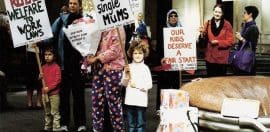Australians in poverty need a bounce-forward recovery

20 January 2021 at 5:38 pm
The economic recovery risks leaving many Australians behind. But it doesn’t have to be this way, write Dr Kate Harrison Brennan and Dr Jeni Whalan, issuing a call to action for the nation’s leaders.
If 2020 has shown us anything, it is that crises – whether bushfires or pandemics – do not affect us all equally.
And while we are all desperate for some good news in the new year, the idea that we can turn the Christmas tree lights on and see the economy snap back in the same way is a naïve fantasy.
Unless we take urgent action, the economic recovery risks leaving many Australians behind and in fact may further compound entrenched poverty in communities across the country.
Triumphant announcements that Australia is “bouncing back” do not ring true for those experiencing poverty and persistent disadvantage. And given the enormous impact COVID-19 has had, and the way it has shone a spotlight on the strengths and weaknesses of our society, simply “bouncing back” is not enough.
We need a recovery that bounces higher – indeed, one that bounces forward.
It won’t be enough to measure recovery through the usual lead indicators of national economic productivity. Rising stock prices and increasing consumer activity are important for job markets but they don’t tell us about the way recovery’s benefits are distributed.
Recent research from the Melbourne Institute, supported by the Paul Ramsay Foundation, tells us that although people and communities move in and out of poverty, there are some who get repeatedly left behind.
The experience of young people who joined the labour market around the time of the global financial crisis is evidence of the enormous impact of such economic events. More than a decade later, their levels of full-time employment had still not caught up when COVID-19 hit.
This recession has already taken an even bigger toll on Australia’s youth, with immediate impacts to their employment, education and training as well as significant effects on mental health and wellbeing.
Will Australia see a cohort of young people – a “Class of Corona” – still struggling to find secure work in a decade’s time?
In 2020, households with lower income disproportionately carried the burden of the pandemic. The second wave of Victoria’s coronavirus outbreak had a far greater impact in disadvantaged areas, a finding that has been echoed by similar studies in the US and UK.
Professionals have shifted to “work from home” bubbles, but essential workers have borne the risks and hardships of frontline work, while hospitality and retail workers, and those in blue-collar industries, have suffered widespread job losses. As with wider poverty rates, the impact has fallen disproportionately on women.
If the economy bounces back for some but not for others – the dreaded “K-shaped” recovery – there’s good reason to believe that COVID’s immediate impact and long tail will further compound entrenched poverty in communities across Australia.
That burden will be borne by young people trying to get an early foothold in an inhospitable jobs market. And it will be borne by the children of those who have lost their jobs during this recession, and those pushed even further out of reach of the market economy.
For them, recovery might look less like a snap-back and more like economic whiplash, leaving chronic but often invisible injuries which carry long-lasting costs for them and for all of us.
But it doesn’t have to be this way. We have the evidence base, the resources, the experience and expertise to enable swift and effective intervention.
If we are to rejoice in the new year, let it be at this prospect: we can act now to prevent the pandemic’s social and economic consequences becoming a permanent on-ramp to cycles of poverty in Australia.
To do so, we must look not only to conventional economic tools and indicators, but also to their second- and third-order effects on the lives of those Australians most vulnerable to long-term disadvantage.
For example, as the Children’s Commissioner Anne Hollonds wrote recently, although the JobKeeper supplement was designed to keep adults connected to work and businesses afloat, it was also a big initiative to promote the wellbeing and the rights of children amid the financial stress and economic insecurity of their parents.
A good, fair and lasting recovery from the COVID-19 recession means we don’t leave behind the children, families and communities most in need of a forward-bounce.
We need to reconnect this generation of young people with the opportunity to fulfil their potential. This is a moral as well as an economic and social imperative which we can’t afford to ignore.









